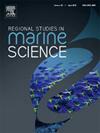华南珠江三角洲区域海平面的历史和未来预测
IF 2.1
4区 环境科学与生态学
Q3 ECOLOGY
引用次数: 0
摘要
由于其地理位置的特殊性,沿海地区不仅受到气候变化和城市化的影响,还受到海平面上升引起的下游边界顶升的影响,这进一步扩大了洪水灾害。因此,有必要对历史海平面进行分析,并对未来的区域海平面进行预测,以预防或减轻沿海地区的洪涝灾害。本研究利用珠江三角洲潮汐站资料及数理统计,分析历史海平面,并建立预测未来珠江三角洲海平面上升的模型。结果表明,珠江三角洲海平面呈显著上升趋势,但珠江口海平面的上升幅度低于其他站点。由于珠江三角洲的城市化,海平面趋势在20世纪90年代发生了重大变化。城市化期间的海平面变化速率比整个研究期间平均高3.4 cm/10a。珠江三角洲海平面变化周期分别为4 ~ 7年、10 ~ 15年、18年和22 ~ 29年。预计未来海平面的波动会更大。不同全球气候模式提供的海平面上升结果不同,但随情景水平的增加而增加。在SSP126、SSP245、SSP370和SSP585情景下,近(长)将来海平面将分别上升22.4 (24.0)cm、31.0 (47.4)cm、39.1 (73.5)cm和45.8 (94.4)cm。本文章由计算机程序翻译,如有差异,请以英文原文为准。
Historical and future projected regional sea levels in the Pearl River Delta, South China
Due to the particularity of its location, coastal areas are not only affected by climate change and urbanization, but also affected by the downstream boundary jacking caused by sea level rise, which further expands the flood disaster. Therefore, it is necessary to analyze historical sea levels and predict future regional sea levels in order to prevent or mitigate flood disasters in coastal areas. This study used tidal station data from the Pearl River Delta (PRD) and mathematical statistics to analyze historical sea levels and establish a model to predict future sea level rise in the PRD. The results showed a significant increase in sea levels in the PRD, but the rate of increase was lower in the Pearl River estuary than at other stations. A substantial change in the sea level trend occurred in the 1990s due to urbanization in the PRD. The rate of sea level change was, on average, 3.4 cm/10a higher during the urbanization period than during the entire study period. The periods of sea levels change in the PRD were 4–7, 10–15, 18, and 22–29 years. Sea level fluctuations were predicted to be higher in the future. Different global climate models provided different results of sea level rise, but the values increased with an increase in the scenario level. The sea level will rise by 22.4 (24.0) cm, 31.0 (47.4) cm, 39.1 (73.5) cm, and 45.8 (94.4) cm in the near (long) future under the SSP126, SSP245, SSP370, and SSP585 scenarios, respectively.
求助全文
通过发布文献求助,成功后即可免费获取论文全文。
去求助
来源期刊

Regional Studies in Marine Science
Agricultural and Biological Sciences-Ecology, Evolution, Behavior and Systematics
CiteScore
3.90
自引率
4.80%
发文量
336
审稿时长
69 days
期刊介绍:
REGIONAL STUDIES IN MARINE SCIENCE will publish scientifically sound papers on regional aspects of maritime and marine resources in estuaries, coastal zones, continental shelf, the seas and oceans.
 求助内容:
求助内容: 应助结果提醒方式:
应助结果提醒方式:


